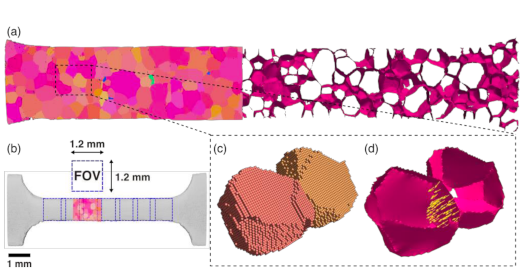
Combining SEM, EBSD and LabDCT to assess slip transfer in titanium
Deformation in polycrystals occur by dislocation slip on so-called slip systems, and grain boundaries (GBs) play a critical role in this process. Slip transfer across a GB is associated with good geometrical alignment between the incoming and outgoing slip systems at the GB, while the lack of continuity between atomic lattices at the GBs hinders slip. Several geometric criteria have been proposed over the years to assess whether slip transfer or blocking will occur at a given GB.
A group of researchers from IMDEA Materials Institute and University of Purdue set out to analyze the slip transfer across more than 300 GBs at the surface of a thin Ti sample with a strong rolling texture by means of SEM-based slip trace analysis, electron backscatter diffraction (EBSD) and LabDCT. The 3D grain shape and boundary information from the LabDCT analysis complemented the 2D SEM and EBSD results with the grain boundary twist angle, which requires 3D information about the orientation of the GB within the sample.
Predictors for slip transfer
Based on the acquired data they assessed the likelihood of slip transfer/blocking as a function of the main angles that characterize the incoming and outgoing slip systems and the GB. For the current sample texture, they found that slip transfer was most likely to occur if the angle between the incoming and outgoing slip directions was less than 25.4 deg, while the twist angle was found to play a very minor role for slip transfer prediction.
Acta Materialia
More by the same authors
Systematically exploring the performance of DCT Advanced Acquisition
